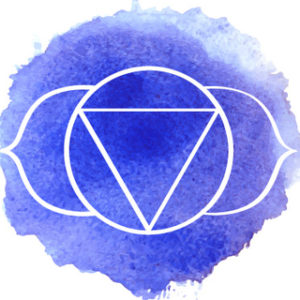This post is part of the Chakras Series. We started by covering what the chakras are and what they represent (Read “What Are The 7 Chakras And Why Do They Matter?”).
In this post, we will focus specifically on the Third Eye Chakra.
- Also known as: “Ajna”, which means “command” and “perceiving”.
- Location: On the forehead, between the eyebrows.
- Color: Purple (or deep indigo).
- What it represents: I SEE. Known as the sixth chakra, it represents your intuition, your ability to plan, forecast, sense, and know.
- Linked to: The third eye chakra is associated with vision, reality, inspiration, intuition, perception of subtle dimensions and movements of energy, access to mystical states, illumination, connection to wisdom, insight. At a physical level, the third eye chakra is associated to the pineal gland in charge of regulating biorhythms, including sleep and wake time. The pineal gland located in the brain that is a center of attention because of its relationship with the perception and effect of light and altered or “mystical” states of consciousness. It’s positioned close to the optical nerves, and as such, sensitive to visual stimulations and changes in lighting.
- You have a balanced third eye chakra when: You see life with clarity and with strong intuition, insight, self-awareness and emotional balance.
- You have a blocked third eye chakra when: You lack clarity, you feel stuck in the daily grind without being able to look beyond your problems, you’re unable to set a guiding vision for yourself, you are closed-minded and reject everything spiritual. You feel cynical, struggle with anxiety, depression, paranoia and various other mental illnesses and mood disorders.
- Healing foods: Nuts, seeds, and legumes — especially raw walnuts, sprouted almonds, and poppy seeds. Metal detoxers from the ground, such as harvest grains and mushrooms. Purple fruits, like goji berries, acai, concord grapes and blackberries.
- Healing yoga poses: Inversions, forward bends, balancing poses and postures that stimulate your forehead. When you are in a pose, breathe deeply and set an intention that helps you feel enlightened. Ideas can be “I am light” or “I am inspired”.
“Here are my favorite yoga poses to stimulate the third eye chakra”

- Balasana: Separate your knees wide and rest your forehead on the floor. Let your whole body relax, while maintaining a straight spine. Press your forehead on the floor, close your eyes and bring your awareness to the third eye. Bring your inner energy onto to this chakra, and let it show you how you would see the world through it. Gently massage your pineal gland by slightly turning your head to the sides. What is needed for you to see? What is relevant, and what isn’t?
- Sun Salutations (with eyes open and then closed): Flow through uttanasana (standing forward bend), ardha uttanasana (half standing forward bend), plank pose, chaturanga dandasana (four limbed staff pose), bhujangasana (cobra pose), adho mukha savasana (downward facing dog) and back to uttanasana and finally tadasana (mountain pose). After a few rounds, try to take a couple of sun salutations with your eyes closed, focusing your attention on your third eye chakra.
- Dandayamana Janushirasana. Standing Head-to-Knee Pose offers a variety of benefits for the body and mind. The full expression of this posture (with the forehead pressing against the knee) does require a lot of practice, flexibility and strength… if you’re not ready for it year, skip to the next posture. While the pose most obviously stretches and strengthens the hamstrings, the triceps and biceps of the upper arm, trapezius and deltoids of the shoulders, and the lateral and upper back muscles are also strengthened. Balancing in the pose requires activation in multiple muscle groups, including the abdominal muscles, and helps develop focus and concentration. The final expression is achieved by pressing the forehead against the knee, stimulating your third eye chakra.
- Janushirasana. Seated head to knee deeply stretches the back of the legs and stimulates the sixth chakra through a compression of the pineal gland. This posture calms the mind and emotions, stimulates the nervous, reproductive, endocrine and urinary systems and promotes clarity and intuition.
- Dandayamana Bibhaktapada Janushirsasana. Standing separate leg head-to-knee is a very complete posture: it opens up your spine with a powerful, inner compression. A deep forward bend with an added hip-opener and stimulation of the fifth and sixth chakras, by compressing the thyroid and pineal glands.
- Virabhadrasana III. Practicing balance can bring energy and awareness into our third eye chakra. When we balance the body, the mind needs to be just as engaged as the body. While in warrior III, close your eyes, take a few breaths here and draw the energy into your third eye chakra.
- Seated meditation. One of the best ways to find contact with your sixth chakra is via meditation. Find yourself in a comfortable seated position, straighten the back and relax the shoulders. Close your eyes. Then, place your hands on your thighs or on your lap, and focus on your breathing. Once more draw your energy onto your third eye, and ask it to show you what you need to see.
The Ajna Chakra is about your inner wisdom and guidance. It’s about being creative and trusting the intuitive messages we receive. For this we sometimes need to do less and rest more. Practice deep breathing, mindfulness and simplify your life. Find moments of silence, close your eyes and allow yourself to see what truly matters.
Happy seeing!
Sonia Ribas
@soniaribascoach


